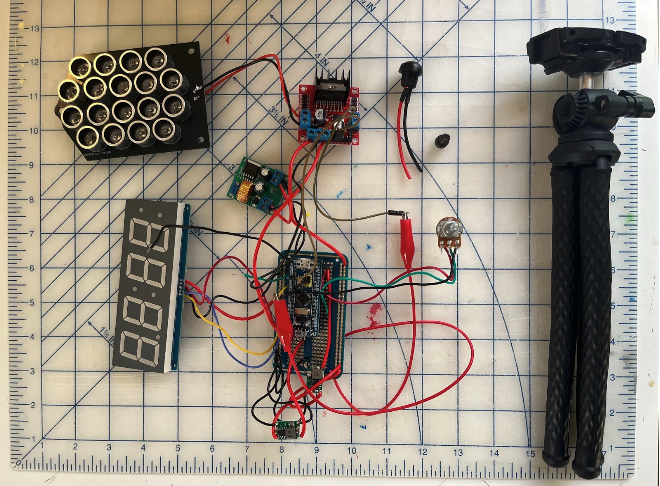
Blog
Grant Project Update: Modulated Ultrasound Alarm Clock
The traditional alarm clock wakes everyone in the room, whether they like it or not, when it propagates audible sound waves. This project was built as a novel solution to that problem. Using a speaker array that projects ultrasonic (inaudible) sound waves that demodulate in the air where they travel, this alarm clock beeps only for the user it is directly pointed at. Through a threaded insert on the bottom, users can mount the clock onto a tripod to point at their bed.

The clock’s speaker is a custom array of eighteen ultrasonic transducers (TCT40-16), which receive 32 V from a dual H-bridge. The speaker encodes audible sound in a 40 kHz wave by modulating the duty cycle proportionally according to the target audible sound. As the sound propagates in the narrow, high-frequency “beam”, it demodulates slightly in the air (and more when it collides with a surface like a pillow). An STM32 handles the clock’s logic, adjusting the alarm time according to a potentiometer and button on the front (capable of disabling it if turned to the side). The system is powered via a 24V DC input, which is stepped down/up to power the 3.3V STM32 logic, 5V display, and 32V speaker array.

This prototype, although mostly functional, wasn’t a seamless user experience. In future work, a better clock could be built on the same speaker mechanism to fix these issues. Currently, the clock outputs a beeping 600 Hz sound at a set volume encoded in a 40 kHz wave; the introduction of volume control and various (non-hardcoded) sounds would be much more pleasant. Additionally, the target where the speaker is pointed effectively emits a weak sound to the rest of the room as the waves demodulate. This is better than a traditional alarm, but not perfect for light sleepers. A more sophisticated system using multiple arrays of transducers could project waves that interfere to create audible sound, reducing the issues associated with surface collision, demodulated waves projecting from where they hit.